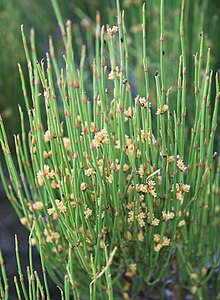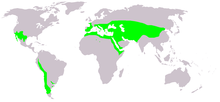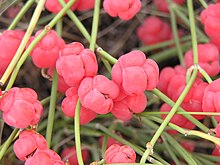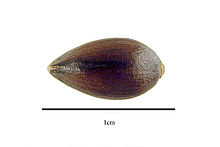
Back علندي Arabic علندى ARZ Acılıqotu Azerbaijani Хвойнік Byelorussian Ефедра Bulgarian Ephedra BS Efedra Catalan Ephedra CEB Chvojník Czech Ledris Danish
| Ephedra Temporal range:
| |
|---|---|

| |
| Ephedra viridis | |
| Scientific classification | |
| Kingdom: | Plantae |
| Clade: | Tracheophytes |
| Clade: | Gymnospermae |
| Division: | Gnetophyta |
| Class: | Gnetopsida |
| Order: | Ephedrales |
| Family: | Ephedraceae |
| Genus: | Ephedra L.[1] |
| Type species | |
| Ephedra distachya | |

| |
| Global range of Ephedra | |
| Synonyms[2] | |
| |
Ephedra is a genus of gymnosperm shrubs. The various species of Ephedra are widespread in many arid regions of the world, ranging across southwestern North America, southern Europe, northern Africa, southwest and central Asia, northern China and western South America.[2] It is the only extant genus in its family, Ephedraceae, and order, Ephedrales, and one of the three living members of the division Gnetophyta alongside Gnetum and Welwitschia.
In temperate climates, most Ephedra species grow on shores or in sandy soils with direct sun exposure. Common names in English include joint-pine, jointfir, Mormon-tea or Brigham tea. The Chinese name for Ephedra species is mahuang (simplified Chinese: 麻黄; traditional Chinese: 麻黃; pinyin: máhuáng; Wade–Giles: ma-huang; lit. 'hemp yellow'). Ephedra is the origin of the name of the stimulant ephedrine, which the plants contain in significant concentration.



- ^ Kramer KU, Green PS, Götz E (1990). Kramer KU, Green PS (eds.). The Families and Genera of Vascular Plants, Vol. 1: Pteridophytes and Gymnosperms. Berlin: Springer-Verlag. pp. 379–381. ISBN 3540517944.
- ^ a b Kew World Checklist of Selected Plant Families